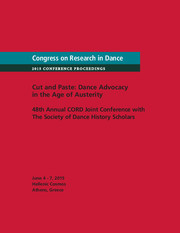No CrossRef data available.
Article contents
Non-Finito in Contemporary Dance Making
Published online by Cambridge University Press: 02 August 2016
Abstract
The affiliation of dance with the academy, which requires a written account and documentation of the process; the impact of the “digital age”; and the visual culture that facilitates the creation of online blogs and promotes projects such as William Forsythe's “choreographic objects” [Synchronous Objects (2009); Motion Bank (2010–2013)]; but also the economic depression, which restricts dance artists from arriving at their final products, might be some of the possible reasons that explain the shift towards the artistic status of non-finito, approached here as a creative process that also manifests through dance scores. However, what is clear so far is that since dance became less and less narrative, the sharing of process inside or outside academia started to increase rapidly, and the value of dance as product is being challenged.
- Type
- Research Article
- Information
- Copyright
- Copyright © Ariadne Mikou 2016


